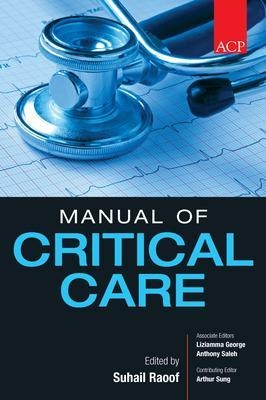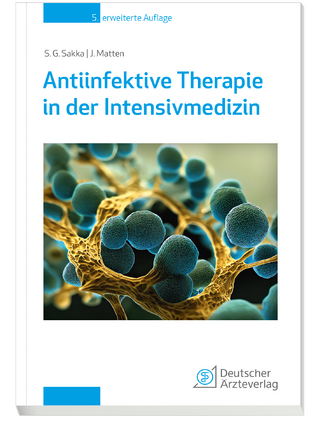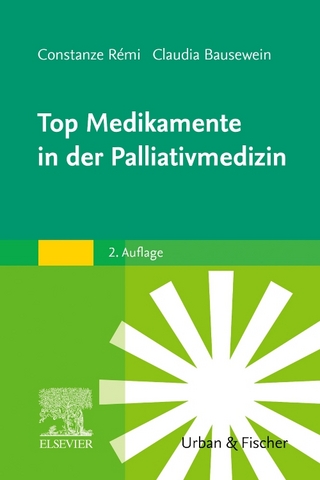
ACP Manual of Critical Care
McGraw-Hill Medical (Verlag)
978-0-07-160565-6 (ISBN)
- Titel z.Zt. nicht lieferbar
- Versandkostenfrei innerhalb Deutschlands
- Auch auf Rechnung
- Verfügbarkeit in der Filiale vor Ort prüfen
- Artikel merken
From the world’s leading organization of internal medicine physicians, this handy guide provides full coverage of the clinical management patients cared for in the intensive care unit. Featuring numerous procedural illustrations, algorithms and clinical pearls! The ACP Manual of Critical Care features a practical format that manages to deliver a lot of content in a way that will appeal to busy residents and non specialists. As a required rotation in internal medicine training and in some nursing fields, the market for this book is large.
The ACP Manual of Critical Care covers all core content areas and all body systems/regions. The book includes a large number of step-by-step clinical procedures in critical care which will be popular with interns and residents.
Suhail Raoof, MD is Professor of Medicine at New York University School of Medicine, and Director of Pulmonary and Critical Care Medicine at New York Methodist Hospital.
Section I. General Aspects of Critical CareA. Commonly Performed ICU ProceduresCh. 1Central Venous Catheterization, Ravi Sundaram and Gnanaraj JosephCh. 2Right Heart Catheterization, Anthony SalehCh. 3Pericardiocentesis & Temporary Cardiac Pacing, Bilal Malik and Suhail AllaqabandCh. 4. Bronchoscopy, Sandeep Mehrishi and Udaya PrakashCh. 5Use of Endoscopic Procedures in the Intensive Care Setting, Maurice A. CerulliCh. 6Use of Ultrasonography in the Critical Care Unit, Paul MayoCh. 7Chest Imaging, Sabiha RaoofCh. 8Administrative Aspects of Critical Care, Lauren YedvabB. Resuscitative TechniquesCh. 9Fluid Resuscitation, Naveed Shahid and Sunil MehraCh. 10The Use of Pressors to Support Circulation, Young H. Lee and Alan S. MultzCh. 11Administration of Blood and Blood Products, Judith A. LuceCh. 12Cardiopulmonary Resuscitation, André de Corla-Souza and Joan McInerneyC. Respiratory Support and MonitoringCh. 13Monitoring Mechanical Ventilatory Support, Douglas Haden and Neil Ross MacIntyre, Jr.Ch. 14Securing the Airway, Karl CribbinCh. 15Use of Percutaneous Dilatational Tracheostomy at Bedside, Arthur Sung, Ann L. Rutt, and David Feller-KopmanCh. 16Introduction to Mechanical VentilationCh. 16, Pt. I Mechanical Ventilation, Frew Gebreab and Anthony SalehCh. 16, Pt. IIVentilatory Management of Specific Causes of Acute Respiratory Failure, Robert M. KacmarekCh. 17Importance of Positioning in the Critically Ill Patient, Richard K. AlbertD. Miscellaneous Issues Specific to the Critical Care UnitCh. 18Management of Anxiety, Agitation, and Depression, Kamil JaghabCh. 19Use of Sedatives and Neuromuscular Blocking Agents, Ali Mojaverian and Michael R. DubinCh. 20Pain Management, Akhtar PurvezCh. 21Prognostication Systems, Erfan Hussain and Mitchell C. JacobsCh. 22Health Care Associated Infections, Maria NinivaggiCh. 23Nutrition Assessment and Support, Lisa MusilloCh. 24Ethics in the Intensive Care Unit, Imran Aurangzeb and Steven WalersteinCh. 25Perioperative Care of the Critically Ill Patient, Kaleem M. Rizvon and Samia QaziSection II. Systemic DisordersA. Cardiovascular Critical CareCh. 26Unstable Angina and Myocardial Infarction, Suhail Allaqaband and Tanvir BajwaCh. 27Cardiogenic Shock, Suhail Allaqaband and Tanvir BajwaCh. 28Heart Failure, Afshan Hameed, Suhail Allaqaband, and Shahbudin H. RahimtoolaCh. 29Recognition and Management of Common Arrhythmias, Vikram Nangia and Masood AkhtarCh. 30Acute Pericarditis, Pericardial Effusion, and Cardiac Tamponade, Ramagopal J. Tumuluri and Suhail AllaqabandCh. 31Aortic Dissection, Ramagopal J. Tumuluri and Suhail AllaqabandCh. 32Hypertensive Emergencies, David B. CaseB. Pulmonary Critical CareCh. 33Acute Respiratory Failure, Nausherwan K. BurkiCh. 34Acute Respiratory Distress Syndrome, Liziamma George Ch. 35Status Asthmaticus, Mani S. Kaavuru and Muzaffar AhmadCh. 36Chronic Obstructive Pulmonary Disease Exacerbations, Andreas c. Kyprianou and Alan M. FeinCh. 37Upper Airway Obstruction, José C. Yataco and Atul C. MehtaCh. 38Pneumonia, Michael S. NiedermanCh. 39Pulmonary Embolism and Deep Venous Thrombosis, Mehdi Khosravi and Kenneth E. WoodCh. 40Pneumothorax, Andreas C. Kyprianou and Ashok M. KarnikCh. 41Pulmonary Arterial Hypertension, Arunabh TalwarCh. 42Critical Care and Sleep Disorders, Gerard T. LombardoC. Critical Care of Renal DiseasesCh. 43Peritoneal Dialysis, Ultrafiltration, Hemofiltration, and Hemodialysis, George CoritsidisCh. 44Acute and Chronic Renal Failure, Lawrence E. Stam and Kotresha NeelakantappaCh. 45Electrolyte Disorders, Sandeep Mehrishi and Donald A. FeinfeldCh. 46Acid-Base Disorders, Ghulam Saydain and Donald A. FeinfeldD. Critical Care of Endocrine and Metabolic DiseasesCh. 47Diabetic Ketoacidosis and Hypoglycemia, Salini C. Kumar and Alice K. LeeCh. 48Thyroid Storm, Myxedema Coma, and Adrenal Crisis, James A. KruseE. Critical Care of Hematological and Oncological DiseasesCh. 49Hemorrhagic Disorders, Bhoomi MehrotraCh. 50Thrombotic Disorders, Michael GarrisonCh. 51Oncologic Emergencies<, Linda CarmosinoCh. 52Adverse Effects of Chemotherapeutic Agents, Sarada Krishnamurthy and Alan Dosik F. Critical Care of Infectious DiseasesCh. 53Antimicrobial Therapy in the Intensive Care Unit, Stephan L. KamholzCh. 54The Systemic Inflammatory Response Syndrome and Septic Shock, Steven Y. Chang, Jonathan Edelson, and Alan M. FeinCh. 55Infective Endocarditis, Tabassum Yasmin and Getachew FelekeCh. 56Infections in HIV Patients and Other Immunocompromised Hosts (Excluding Pulmonary and CNS Infections), Neelam Patel and Muddasar ChaudryCh. 57Respiratory Failure in Patients with HIV Infection, Mangala Narasimhan and Mark J. RosenCh. 58Infections of the Central Nervous System, Mohamed Bakry and Fernando PujolCh. 59Other Serious Community-Acquired and Nosocomial Infections, William R. Berrington and W. Conrad LilesG. Critical Care of Gastrointestinal DiseasesCh. 60Gastrointestinal Bleeding, Bharat K. MisraCh. 61Acute Abdomen and Acute Pancreatitis, Hassan Borghei and Vincent Notar-FrrancescoCh. 62Acute Liver Failure, Mohammad Sultan KhurooH. Critical Care of Neurological DiseasesCh. 63Seizures, Satish Kadakia and Bernard BerkowitzCh. 64Muscular Weakness, Joel S. DelfinerCh. 65Coma and Brain Death, Ayman Bishay and Imran WahednaCh. 66Stroke and Cerebrovascular Disorders, Sophia R. SharfsteinI. Critical Care of Rheumatological and Autoimmune DiseasesCh. 67Autoimmune Diseases, Prachi Anand and Steven CarsonsCh. 68Anaphylaxis, Marianne FrieriJ. Environmental EmergenciesCh. 69Temperature-Related Illnesses, Sreenivasa R. Chanamolu, Venkata D. Bandi, and Kalpalatha K. GuntupalliCh. 70Burns, Roger L. SimpsonCh. 71Near Drowning, Anup Banerjee and Praveen N. MathurCh. 72Poisoning and Drug Overdose, Kent Smitherman and Janice L. ZimmermanK. Critical Care of the Pregnant PatientCh. 73Critical Care of the Pregnant Patient, Kyle Hogarth and Jesse HallAppendixesI. Part One: Commonly used Parameters and Formulae in Critical CareI-1.Hemodynamic Variables
I-2.Pulmonary Formulae
I-3.Renal Formulae
I-4.Common Conversion Formulae
I-5.Estimated Osmolol Concentrations of Organic Solvents
I-6.Metabolism and NutritionI. Part Two: Commonly Used Laboratory Tests and Their InterpretationI-7. Cardiac Enzymes
I-8. Nutritional Assessment Using Plasma Proteins
I-9. Patterns of Liver Function Test Abnormalities
I-10. Pancreatic Function Evaluation
I-11. Acute-Phase Reactants
I-12. Causes of Lactic Acidosis
I-13. Causes of Thyroid Function Test Abnormalities in Acute IllnessII: Advanced Cardiac Life Support (ACLS) ProtocolsII-1. Management of Pulseless Arrest
II-2. Management of Tachycardia
II-3. Management of BradycardiaIII: Cardiovascular SystemIII-1.Management of Suspected Acute Myocardial Infarction
III-2a.Clues to Etiology (Ventricular vs. Supraventricular Wide QRS Complex Tachycardia (WCT)
III-2b. Distinguishing VT from SVT With Aberrancy
III-3. Medications Used For Treating Hypertensive EmergenciesIV:Shock States and Related IssuesIV-1.Sepsis, Septic Shock, and Multiorgan Dysfunction
IV-2.APACHE II Scoring System
IV-3. Management of Sepsis (Including Early Goal-Directed and Subsequent Therapy)
IV-4.Hemodynamic Parameters in Shock
IV-5a.Properties of Vasopressor Receptors in Regulating Hemodynamics
IV-5b. Doses and Effects of Medications Used for Hemodynamic Regulation
IV-6.Initial Management of Anaphylaxis for Patient Presenting with Urticaria, Pruritis, Stridor, Respiratory Distress, or HypotensionV:Pulmonary SystemV-1.Etiology of Respiratory Failure
V-2.Definition of Acute Lung Injury/ARDS
V-3.NIH NHLBI ARDS Clinical Network Mechanical Ventilation Protocol Summary
V-4.Mechanical Ventilation in COPD
V-5.Noninvasive Positive Pressure Ventilation for COPD Exacerbation
V-7.Patient Ventilator/Dyssynchrony
V-8.Weaning Guidelines
V-9.Oxygen Delivery Systems
V-10.Management of Acute Exacerbation of Bronchial Asthma
V-11a.Diagnostic Approach for Pulmonary Embolism
V-11b.Well’s Pre-Test Probability for Pulmonary Embolism
V-11c.Management of Pulmonary Embolism
V-12.Management of Severe Pneumonia
V-13.Chest Roentgenographic Patterns in HIV-Infected Patients
V-14.Management of Pneumothorax
V-15.Management of Upper Airways Obstruction VI:Central Nervous SystemVI-1.Management
of Acute Stroke (<3 hr)
VI-2.Glasgow Coma Scale
VI-3.Suggested Protocol for Convulsive Status EpilepticusVII:Renal SystemVII-1.Expected Compensation of Simple Acid Base Disorders
VII-2.Risk, Injury, Failure, Loss, and End-Stage Kidney Disease (RIFLE) Classification
VII-3.Management of Hypernatremia
VII-4.Management of Hyponatremia
VII-5.Composition of Intravenous Fluids Commonly Used in Critical Care UnitsVIII:Endocrine SystemVIII-1.Management of Adult Patients with Diabetic Ketoacidosis and Hyperosmolar Non-Ketotic Coma IX:Hematologic SystemIX-1.Management of Thrombocytopenia
IX-2.Management of Elevated PTT/Normal PT
IX-3.Management of Elevated PT X:Infectious DiseasesX-1.Empiric Therapy for Febrile Neutropenia
X-2.Management of Suspected Catheter-Related Bloodstream Infection XI:Gastrointestinal SystemXI-1.Hepatic Encephalopathy Clinical Stages
XI-2.Child-Pugh ClassificationXII:MiscellaneousXII-1a.Initial Evaluation of Suspected Overdose/Poisoned Patient
XII-1b.Common Causes of Toxins/Poisons and Their Clinical Findings
XII-1c. Laboratory Derangements in Some Common Poisonings
XII-2. Management of Agitated Patient
XII-3. FLACC (Face, Legs, Activity, Cry, Consolability) Scale for Pain Assessment in Nonverbal Patients Who are Unable to Provides Reports of Pain
XII-4. Richmond Agitation Sedation Scale (RASS)
XII-5. Nutrition Support
Index
| Erscheint lt. Verlag | 16.10.2008 |
|---|---|
| Zusatzinfo | 0 Illustrations |
| Verlagsort | New York |
| Sprache | englisch |
| Maße | 152 x 229 mm |
| Gewicht | 1196 g |
| Themenwelt | Medizin / Pharmazie ► Medizinische Fachgebiete ► Intensivmedizin |
| ISBN-10 | 0-07-160565-7 / 0071605657 |
| ISBN-13 | 978-0-07-160565-6 / 9780071605656 |
| Zustand | Neuware |
| Haben Sie eine Frage zum Produkt? |
aus dem Bereich


